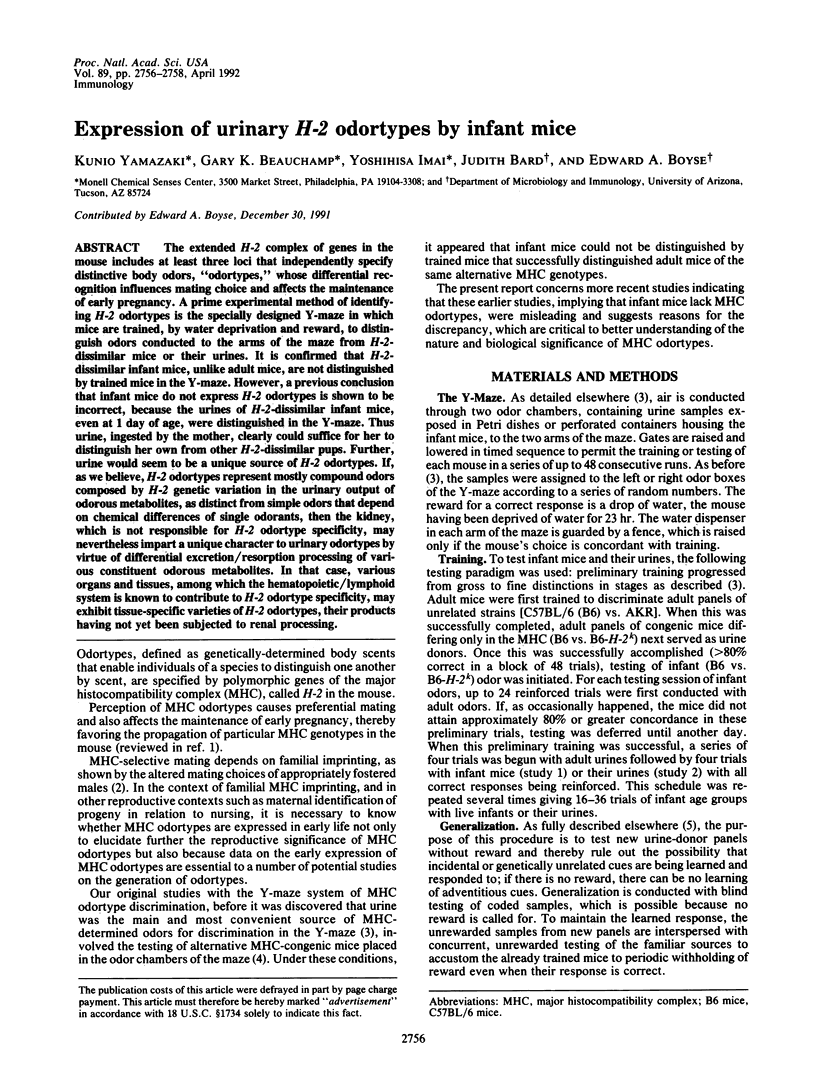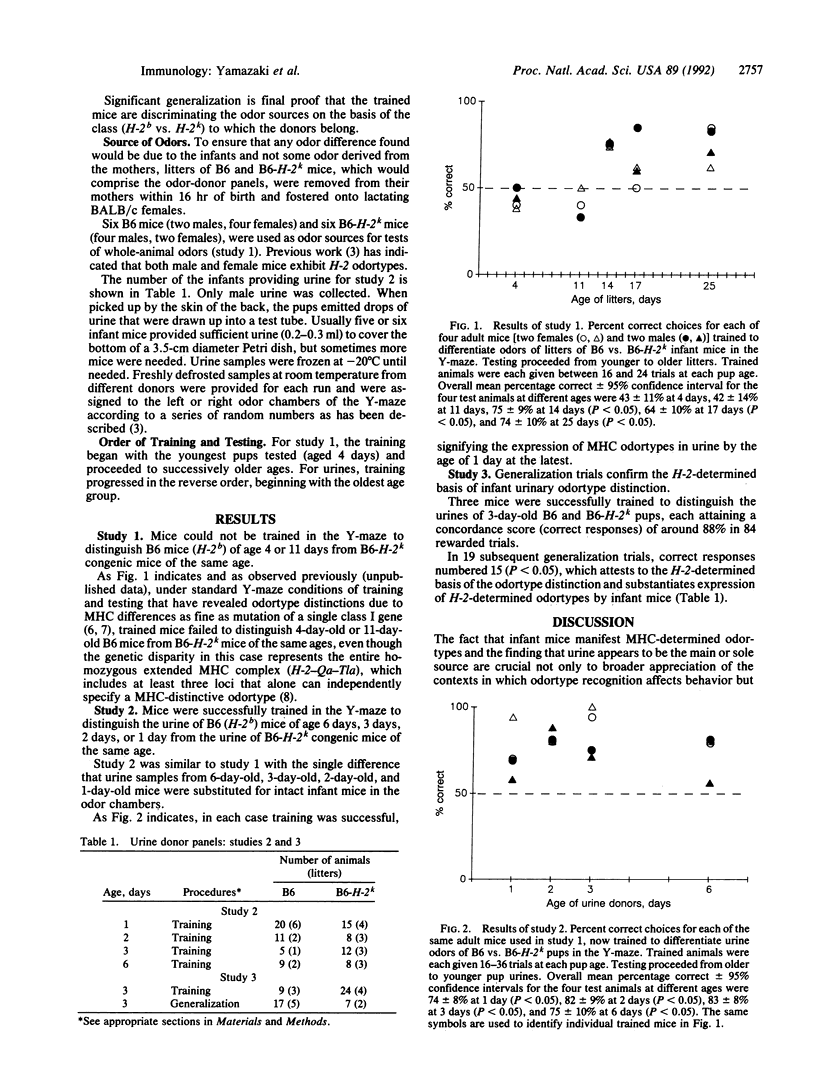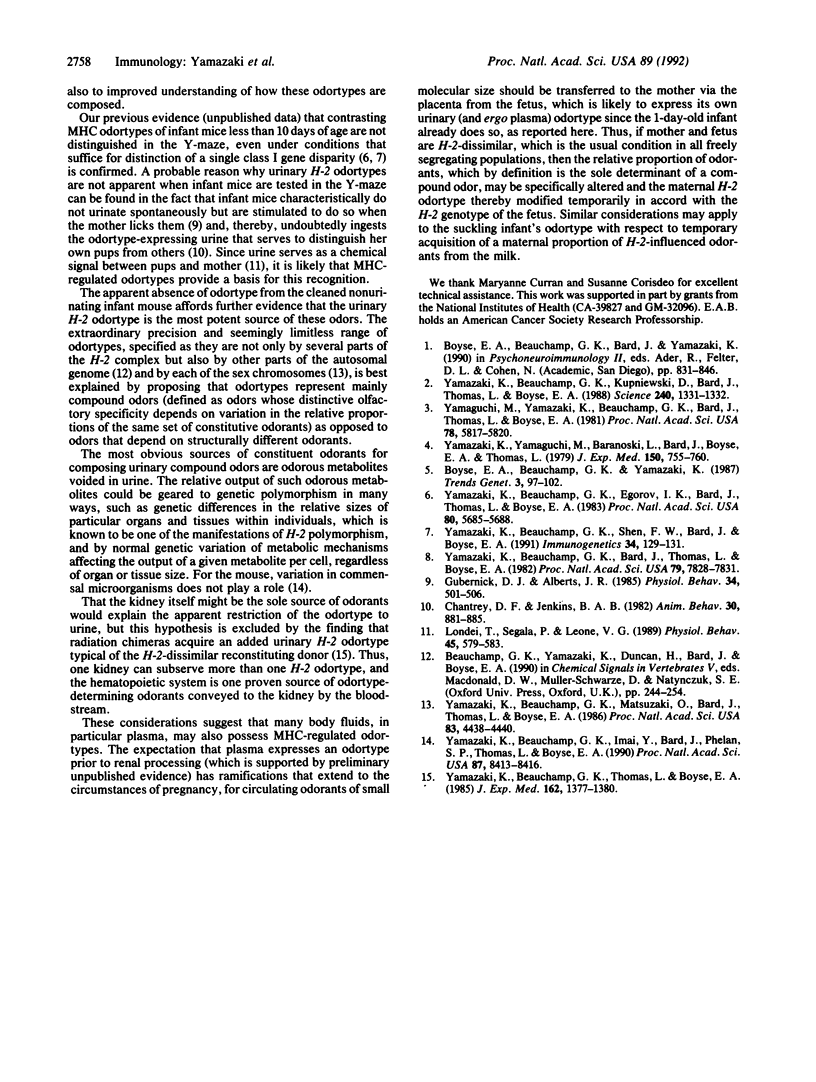Abstract
The extended H-2 complex of genes in the mouse includes at least three loci that independently specify distinctive body odors, "odortypes," whose differential recognition influences mating choice and affects the maintenance of early pregnancy. A prime experimental method of identifying H-2 odortypes is the specially designed Y-maze in which mice are trained, by water deprivation and reward, to distinguish odors conducted to the arms of the maze from H-2-dissimilar mice or their urines. It is confirmed that H-2-dissimilar infant mice, unlike adult mice, are not distinguished by trained mice in the Y-maze. However, a previous conclusion that infant mice do not express H-2 odortypes is shown to be incorrect, because the urines of H-2-dissimilar infant mice, even at 1 day of age, were distinguished in the Y-maze. Thus urine, ingested by the mother, clearly could suffice for her to distinguish her own from other H-2-dissimilar pups. Further, urine would seem to be a unique source of H-2 odortypes. If, as we believe, H-2 odortypes represent mostly compound odors composed by H-2 genetic variation in the urinary output of odorous metabolites, as distinct from simple odors that depend on chemical differences of single odorants, then the kidney, which is not responsible for H-2 odortype specificity, may nevertheless impart a unique character to urinary odortypes by virtue of differential excretion/resorption processing of various constituent odorous metabolites. In that case, various organs and tissues, among which the hematopoietic/lymphoid system is known to contribute to H-2 odortype specificity, may exhibit tissue-specific varieties of H-2 odortypes, their products having not yet been subjected to renal processing.
Full text
PDF


Selected References
These references are in PubMed. This may not be the complete list of references from this article.
- Gubernick D. J., Alberts J. R. Maternal licking by virgin and lactating rats: water transfer from pups. Physiol Behav. 1985 Apr;34(4):501–506. doi: 10.1016/0031-9384(85)90040-x. [DOI] [PubMed] [Google Scholar]
- Londei T., Segala P., Leone V. G. Mouse pup urine as an infant signal. Physiol Behav. 1989 Mar;45(3):579–583. doi: 10.1016/0031-9384(89)90076-0. [DOI] [PubMed] [Google Scholar]
- Yamaguchi M., Yamazaki K., Beauchamp G. K., Bard J., Thomas L., Boyse E. A. Distinctive urinary odors governed by the major histocompatibility locus of the mouse. Proc Natl Acad Sci U S A. 1981 Sep;78(9):5817–5820. doi: 10.1073/pnas.78.9.5817. [DOI] [PMC free article] [PubMed] [Google Scholar]
- Yamazaki K., Beauchamp G. K., Bard J., Thomas L., Boyse E. A. Chemosensory recognition of phenotypes determined by the Tla and H-2K regions of chromosome 17 of the mouse. Proc Natl Acad Sci U S A. 1982 Dec;79(24):7828–7831. doi: 10.1073/pnas.79.24.7828. [DOI] [PMC free article] [PubMed] [Google Scholar]
- Yamazaki K., Beauchamp G. K., Egorov I. K., Bard J., Thomas L., Boyse E. A. Sensory distinction between H-2b and H-2bm1 mutant mice. Proc Natl Acad Sci U S A. 1983 Sep;80(18):5685–5688. doi: 10.1073/pnas.80.18.5685. [DOI] [PMC free article] [PubMed] [Google Scholar]
- Yamazaki K., Beauchamp G. K., Imai Y., Bard J., Phelan S. P., Thomas L., Boyse E. A. Odor types determined by the major histocompatibility complex in germfree mice. Proc Natl Acad Sci U S A. 1990 Nov;87(21):8413–8416. doi: 10.1073/pnas.87.21.8413. [DOI] [PMC free article] [PubMed] [Google Scholar]
- Yamazaki K., Beauchamp G. K., Kupniewski D., Bard J., Thomas L., Boyse E. A. Familial imprinting determines H-2 selective mating preferences. Science. 1988 Jun 3;240(4857):1331–1332. doi: 10.1126/science.3375818. [DOI] [PubMed] [Google Scholar]
- Yamazaki K., Beauchamp G. K., Matsuzaki O., Bard J., Thomas L., Boyse E. A. Participation of the murine X and Y chromosomes in genetically determined chemosensory identity. Proc Natl Acad Sci U S A. 1986 Jun;83(12):4438–4440. doi: 10.1073/pnas.83.12.4438. [DOI] [PMC free article] [PubMed] [Google Scholar]
- Yamazaki K., Beauchamp G. K., Shen F. W., Bard J., Boyse E. A. A distinctive change in odortype determined by H-2D/L mutation. Immunogenetics. 1991;34(2):129–131. doi: 10.1007/BF00211425. [DOI] [PubMed] [Google Scholar]
- Yamazaki K., Beauchamp G. K., Thomas L., Boyse E. A. The hematopoietic system is a source of odorants that distinguish major histocompatibility types. J Exp Med. 1985 Oct 1;162(4):1377–1380. doi: 10.1084/jem.162.4.1377. [DOI] [PMC free article] [PubMed] [Google Scholar]
- Yamazaki K., Yamaguchi M., Baranoski L., Bard J., Boyse E. A., Thomas L. Recognition among mice. Evidence from the use of a Y-maze differentially scented by congenic mice of different major histocompatibility types. J Exp Med. 1979 Oct 1;150(4):755–760. doi: 10.1084/jem.150.4.755. [DOI] [PMC free article] [PubMed] [Google Scholar]


